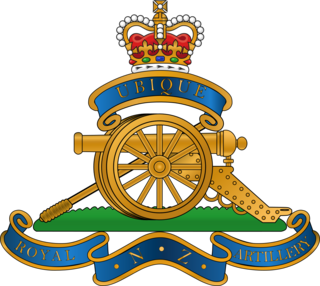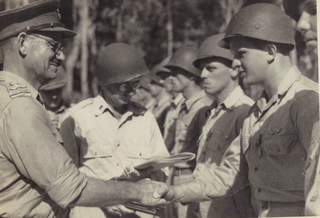
The New Zealand Expeditionary Force (NZEF) was the title of the military forces sent from New Zealand to fight alongside other British Empire and Dominion troops during World War I (1914–1918) and World War II (1939–1945). Ultimately, the NZEF of World War I became known as the First New Zealand Expeditionary Force. The NZEF of World War II was known as the Second New Zealand Expeditionary Force (2NZEF).

The Royal Regiment of New Zealand Artillery is the artillery regiment of the New Zealand Army. It is effectively a military administrative corps, and can comprise multiple component regiments. This nomenclature stems from its heritage as an offshoot of the British Army's Royal Artillery. In its current form it was founded in 1947 with the amalgamation of the regular and volunteer corps of artillery in New Zealand. In 1958 in recognition of services rendered it was given the title the Royal Regiment of New Zealand Artillery.

The Corps of Royal New Zealand Engineers is the administrative corps of the New Zealand Army responsible for military engineering. The role of the Engineers is to assist in maintaining friendly forces' mobility, deny freedom of movement to the enemy, and provide general engineering support. The corps has been involved in numerous conflicts over the course of its history including World War I, World War II, the Korean War, the Vietnam War and the war in Afghanistan. The corps consists of a single regiment, 2nd Engineer Regiment, primarily based at Linton Military Camp near Palmerston North.

The 3rd New Zealand Division was a division of the New Zealand Military Forces. Formed in 1942, it saw action against the Japanese in the Pacific Ocean Areas during the Second World War. The division saw action in the Solomon Islands campaign during 1943–1944, during which it undertook landings on Vella Lavella, the Treasury Islands and the Green Islands. Due to manpower shortages, for most of its existence the division consisted of only two infantry brigades in addition to support personnel, with its third brigade being disbanded shortly after formation. In 1944, manpower shortages in the New Zealand economy became acute led to the disbandment of the division. The majority of its manpower was returned to civilian employment, although around 4,000 men were sent to Italy to reinforce the 2nd Division, seeing further action before the end of the war in May 1945.
N Force was a small New Zealand Army unit of infantry and artillery that garrisoned the Australian territory of Norfolk Island between October 1942 and February 1944, during the Second World War. The island was considered strategically important due to the cable station there that linked Australia and New Zealand. N Force was formed by detaching units from the 3rd New Zealand Division. An airfield was also constructed that was manned by Royal New Zealand Air Force (RNZAF) personnel.

The 6th Armoured Division was an armoured division of the British Army, created in September 1940 during the Second World War and re-formed in May 1951 in the UK.

The 8th Brigade was a formation of the New Zealand Military Forces, which served during the Second World War as part of the 2nd New Zealand Expeditionary Force. Eventually forming part of the 3rd Division, the brigade served in the Pacific Ocean theatre of the war. Raised in late 1940, initially the brigade was employed on garrison duties on Fiji before returning to New Zealand in mid-1942. In December 1942, it was sent to New Caledonia where they remained until early September 1943, when they moved to Guadalcanal to prepare for operations in the Solomon Islands. The brigade's only combat operation of the war came in October–November 1943, when it captured the Treasury Islands. It was disbanded in late 1944 due to manpower shortages in the New Zealand economy.

The 1st Brigade is currently the largest unit of the New Zealand Army, and contains most of the army's deployable units. The brigade was formed on 13 December 2011 by amalgamating the 2nd Land Force Group and 3rd Land Force Group. Its establishment formed part of the 'Army 2015' package of reforms.
The 1st Division was one of three New Zealand Army home defence divisions formed during World War II. The unit was established on 1 November 1941 and was responsible for protecting the northern region of New Zealand's North Island from invasion. The 1st Division was placed on alert during the early months of the Pacific War, but no threat developed. The division was greatly reduced in size during 1943 and was disbanded on 1 April 1944.
The 4th Division was one of three home defence divisions of the New Zealand Military Forces formed during World War II. The unit was established on 1 November 1941 and was responsible for protecting the southern part of New Zealand's North Island from invasion. The division was greatly reduced in size during 1943 and was disbanded on 1 April 1944 without seeing combat.
The 35th Battalion was an infantry battalion of the New Zealand Military Forces, which served in the Pacific theatre of the Second World War from 1941 to 1944. Attached to the 14th Brigade, the battalion was formed in late 1941 and saw service in the Pacific against the Japanese as part of the New Zealand 3rd Division. It initially performed garrison duties on Fiji and New Caledonia before being committed to the fighting in the Solomon Islands in 1943. Returned to New Zealand in late 1944, the battalion was disbanded in early 1945 during a partial demobilisation of New Zealand forces. Many of its personnel returned to civilian employment while others were sent to Italy as reinforcements for the New Zealand 2nd Division. The battalion was awarded four battle honours for its various engagements during the war.
Major General Walter Sneddon McKinnon, was an officer in the New Zealand Army. He joined the military in 1935 and served in the Second World War with various artillery units of the Second New Zealand Expeditionary Force. After the war he held a series of senior positions in the army, culminating with a term as Chief of the General Staff from 1965 to 1967. In his retirement, he was Chairman of the New Zealand Broadcasting Corporation.

The New Zealand Army use of tanks from after the First World War, through the interwar period, the Second World War, the Cold War and to the present day has been limited, but there is some history. The New Zealand armed forces developed in the early twentieth century but served alongside the British and other Empire and Commonwealth nations in World War I and World War II.
The 29th Battalion was an infantry battalion of the New Zealand 3rd Division, raised for service during the Second World War. Serving in the Pacific, the battalion mainly undertook garrison duties and labouring tasks in Fiji and New Caledonia, but saw brief combat against the Japanese in the Treasury Islands in late 1943. In late 1944, the battalion returned to New Zealand and was broken up to provide reinforcements for the New Zealand 2nd Division in Italy. It was eventually disbanded in January 1945.

The 30th Battalion was an infantry battalion of the New Zealand 3rd Division, raised for service during the Second World War. After being raised in late 1940, the battalion undertook garrison duties in Fiji and on New Caledonia during the early part of the war, before undertaking combat operations during the latter part of the Solomon Islands campaign, landing on Vella Lavella and the Green Islands in 1943–1944. The battalion was disbanded in mid-1944 to return manpower to the New Zealand economy and to provide reinforcements to the New Zealand 2nd Division, which was fighting in Italy.

The 29th Light Anti-Aircraft Regiment was an air defence regiment of the New Zealand Military Forces raised during the Second World War. It saw service as part of the 3rd New Zealand Division during the Solomon Islands campaign and was disbanded in October 1944.

The Hawke's Bay Regiment was a territorial infantry regiment of the New Zealand Military Forces. The regiment traced its origins to the Napier Rifle Volunteer Rifles, a volunteer corps formed in 1863 and which would later amalgamate with other volunteer corps to form the 9th Regiment in 1911. During the First World War, the regiment provided a company to each of the battalions of the Wellington Infantry Regiment and saw combat at Galipolli and on the Western Front. After the war the regiment was renamed the Hawke's Bay Regiment and remained in New Zealand for home defense during the Second World War. Men from the regiment, however, served with the 19th, 22nd, 25th and 36th Battalions of the Second New Zealand Expeditionary Force. The regiment had a close relationship with the Ruahine Regiment, which was detached and reabsorbed by the Hawke's Bay regiment on two separate occasions. In 1964, the Hawkes Bay regiment was amalgamated with the Wellington Regiment and become the 7th Battalion, Royal New Zealand Infantry Regiment

Brigadier Raymond Candlish Queree, was a senior officer in the New Zealand Military Forces during the Second World War and the postwar period.

The Northland Regiment was a territorial infantry regiment of the New Zealand Military Forces. The Regiment was formed in 1911 and provided service companies to the Auckland Infantry Regiment during the First World War. Men from the Regiment also served with the 18th, 21st, 24th and 29th battalions of the 2nd New Zealand Expeditionary Force during the Second World War. The regiment was amalgamated with the Auckland Regiment in 1964, becoming 3rd Battalion, Royal New Zealand Infantry Regiment.

The 17th Field Regiment was an artillery regiment of the New Zealand Military Forces raised during the Second World War. The regiment was formed on 2 September 1942 at Papakura Military Camp and consisted of 35 and 37 Batteries, which had formerly operated as independent batteries based in Fiji. In October they were joined by 12 Battery from the Territorial Force and the regiment departed for New Caledonia at the end of December. In September and October 1943, 17th Field Regiment took part in the Land Battle of Vella Lavella as part of the 14th Brigade Group and in February 1944 also took part in the Battle of the Green Islands. Due to manpower shortages, 17th Field Regiment was effectively disbanded in October 1944 along with the rest of the 3rd Division, although a small accounting party continued to exist until April 1945 to complete regimental records. Many of the men were sent with the 14th and 15th reinforcements to the 2nd New Zealand Division.














